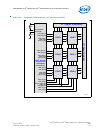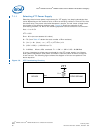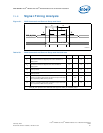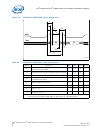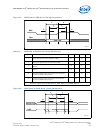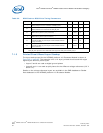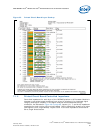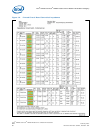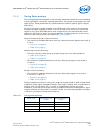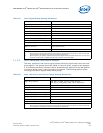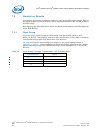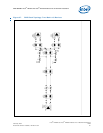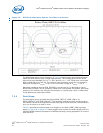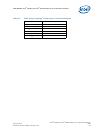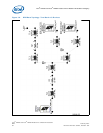
Intel
®
IXP45X and Intel
®
IXP46X Product Line of Network Processors
February 2007 HDD
Document Number: 305261, Revision: 004 87
DDR-SDRAM—Intel
®
IXP45X and Intel
®
IXP46X Product Line of Network Processors
7.1.5 Timing Relationships
The routing guidelines presented in the following subsections define the recommended
routing topologies, trace width, spacing geometries, and typical routed lengths for each
signal group. These parameters are recommended to achieve optimal signal integrity
and timing.
All signal groups are length matched to the DDR clocks. The clocks on the processor
module are length matched to within ±10 mils of each other. Once this overall clock
length for any given DDR differential clock is determined, the command and control
signals can be routed to within the timing specified. A simple summary of the timing
results for each signal group is provided Table 33 on page 87.
Control/Command Group to Clock Summary:
• The maximum allowable difference from any command/control signal to the clock is
±0.6 ns.
— Figure 31 on page 81
— Table 29 on page 81
Data Group to Strobe Summary:
• The more restrictive data group to strobe timing occurs for read operations
— Table 30 on page 82
— Table 31 on page 83
• The maximum allowable difference from any data group signal to the strobe is
±0.25 ns.
— Figure 32 on page 82
— Table 30 on page 82
Strobe to Clock Summary:
• The maximum allowable difference from any data strobe signal to the clock is -
0.475 ns to +0.875 ns
— Figure 34 on page 83
— Table 32 on page 84
These are absolute maximum ratings for length mismatch based in ideal printed board
conditions (exact signal propagation delays, ideal signal integrity with no reflections or
settling, zero rise/fall times, etc.) In order to compensate for these non-ideal
conditions, more restrictive length matching conditions should be used based on signal
integrity analysis and simulation to provide a buffer zone and avoid possible variations
in silicon or printed circuit board manufacture.
Table 33. Timing Relationships
Signal Group
Absolute Minimum
Length
Absolute Maximum
Length
Control to Clock Clock – 600 ps Clock + 600 ps
Command to Clock Clock – 600 ps Clock + 600 ps
Data to Strobe Strobe – 250 ps Strobe + 250 ps
Strobe to Clock Clock – 475 ps Clock + 875 ps



